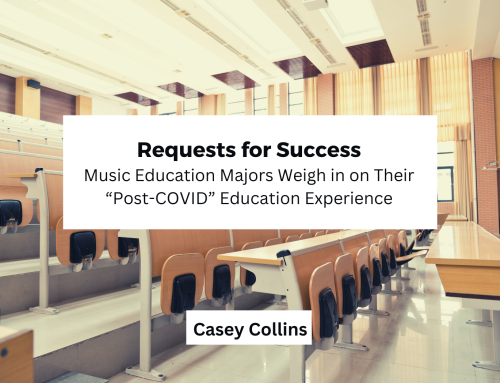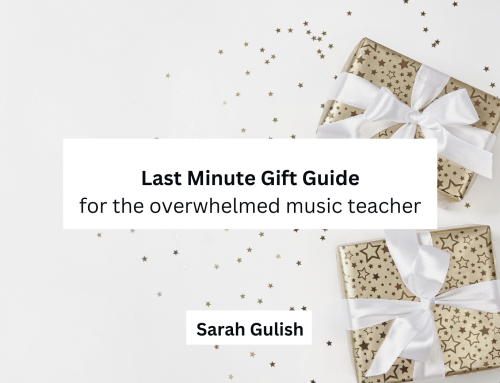I am a music education college professor who teaches both undergraduate and graduate courses. I also keep a foot in the schools by teaching one day a week at a PreK–6 Montessori school. What you are about to read is my specific response to the crisis in which we find ourselves. I know that everyone is different and that what worked for me may not work for others. I am also in a situation where I do not have to worry about childcare or other family members. I firmly believe that there is no “right” way to respond. Setting boundaries and striving for balance is simply my way of managing my anxiety.
The week our nation truly started to take COVID-19 seriously was a whirlwind of communications and changing information, as I’m sure it was for you. The move to remote learning occurred over my spring break, so in essence, I got no spring break. Others, I know, had simply days to get their materials together. In any case, it was a nightmare for all.
I found it hard to tear myself away from the constant stream of information. I listened to my state governor give daily updates, watched countless stories that people posted on Facebook about their experiences with the virus, had waves of high anxiety (Do I have the virus? Am I going to die?) and scrolled endlessly through Facebook and Instagram seeing everyone’s reactions. The emails. THE. EMAILS. The hilarity of getting “We care about you” emails from websites and organizations I had long forgotten I had visited and given my email. The deluge of online teaching resources, tutorials, help hours, websites, webinars, Google docs, Facebook videos, Facebook group invites—STOP!
Stop.
But it was hard to stop. It was hard to keep my mind from racing. I was logging in 12+ hours on my devices, most of it essential to get things organized for my teaching and to respond to people.
Then, a single message caught my brain and cut through all the hysteria in my inbox. “Control what you can.” A day later, something else stuck: “Make a schedule and set your boundaries.”
Breathe in. Breathe out.
Yes, this sounded like a plan. Making a schedule is something I can control. Deciding when to check my devices and not having them on a constant stream was setting boundaries. Here are some steps I took to manage my anxiety during this crisis.
Then, a single message caught my brain and cut through all the hysteria in my inbox. “Control what you can.”
Table of Contents
1. Know when your brain power is best and do your most important tasks then.
I’m a morning bird, and so any heavy brain work must happen before noon. I do all of my creative/research writing, editing, and admin work that requires actual thinking then.
2. Give that “brain power” time a structure and do your best to keep your appointments to yourself.
I am a part of a Writing Support Group that meets 9:45-11:45 during the workweek. We chat for about 15 minutes and catch up, then mute our microphones, and silently work “with” each other for the next hour and 45 minutes. We unmute at 11:45 and share what we’ve accomplished. That is my schedule for creative writing. I do not do edits for students, answer emails, or work on my classes. This is ME time. Time for my research and writing projects, which is a huge part of my job as a professor (it counts for 40% of my job). This will look different depending on the work you do. For many, a block like this could be for lesson planning with teacher friends.
Prior to 9:45, I will usually do other kinds of heavy mental work. Today was working on accreditation documents. Another day was editing a student paper and grading assignments. So far, having this kind of morning brain “duty” first thing has helped me feel like I am going somewhere…even though I am stuck at home.
3. Take time to move
As a high-anxiety person, exercise helps to bring me back to center. I try to get something in each day, to varying degrees of success. But, my favorite way to move and get away from my computer is Yoga with Adriene on YouTube. She takes you through slowly, talks to you in a very “Mr. Rogers” sort of way, and is very cognizant of the different body types she is serving—she often offers adjustments if a position is not working for you. Check her out. Seriously, she saved my life when my sister passed away and was one of the few things that soothed the pain in my heart and mind. She currently has a playlist called Yoga for Uncertain Times, which I have found tremendously helpful. I usually stick to doing yoga first thing in the morning.
If the weather is nice, I go for a run. Running works for me, it may not for you. Maybe you like to walk your dog around the neighborhood. Maybe you enjoy workout videos. Recently, I’ve also been calling people and walking (since I don’t have a dog). Whatever it is, some cardio is a good thing for easing the anxiety and will help you feel happier. As Elle Woods from “Legally Blonde” said,
4. Eat healthy (mostly)
The first grocery trip I took when COVID-19 hit included a lot of my favorite junk food, which I usually don’t buy because if it’s not in the house, I don’t eat it. I made an exception due to the stress I was feeling. I inhaled everything within the first week and felt like shit. There is truth to “you are what you eat.” All I’m saying is that it’s probably best to eat as healthy as you can, and “Treat yo’ self” only occasionally.
5. Set time for email/phone checking
I have gotten tremendously better about this over the years and it has helped me feel better. Don’t leave your email open all day. Don’t. Almost nothing is so important that it can’t be answered a day later or later in the day. For me, I try to set email aside until I’m done with my morning work. Otherwise, I get sucked in and then get none of the heavy mental work done that I KNOW I need to do first thing. Same with the phone. I try to leave it in another room when I’m doing my brain-heavy work. Emails usually get answered in the afternoon for me.
6. Less is more
Now to address more work stuff. Here is my suggestion for cracking open that folder you probably made in your inbox for all the electronic resources you have been sent.
I read a lot of information, talked to a few people, then delved into working on a select number of new things. For me, it was SoundTrap, BandLab, and SeeSaw. I waited though, to talk to my college students before making any decisions. Boy, am I glad I did. I shared what I explored with them and we had an open discussion. I learned about what they did/did not have access to (in terms of instruments). I learned about other classes they were taking and how a lot of my original ideas for our class adapting to online instruction were already covered in their music technology class. We referred back to the learning objectives for the class again and we were able to settle on a collaborative assignment on BandLab. They also wanted to try out editing one lesson resource on SeeSaw. We decided on what days to meet virtually. I kept track of who talked and specifically called on my quiet students to provide their input (so often in these Zoom meetings the most extroverted people are the only ones who get heard).
I took the same approach to gathering materials for my preK–6 students. I observed a lot of what people were posting, then thought about the situation at home for my students. I talked to my principal and considerations for when our school would or would not be back in session. I finally started recording materials. They were simple songs with movements or dances. Nothing too complicated. Something they could do alone or with their families. No equipment necessary beyond their own voices and bodies. Check it out here if you are interested.
When COVID-19 changed our world, everyone and everything immediately reacted. There was a deluge of information dumped across various platforms. I understood the reactions and appreciated the generosity, but it was overwhelming for me. Setting boundaries and striving for balance has lowered my anxiety during this crisis. I hope that some of my ideas resonate with you. I hope that creating a schedule that prioritizes your health and personal goals is possible for you and useful. Balancing time to simply live healthy and to get work done can be extremely difficult, especially if you have less control over your time due to obligations to childcare or other family members. I wish everyone the best and would like to end this post with the words of my state governor that have given me great comfort, every day at 5pm (another routine that has stabilized my life). “We will get through this. We will get through this together.”
If you want to read more about Martina and her work, check out her book, The Art of Child’s Play.




Great article!